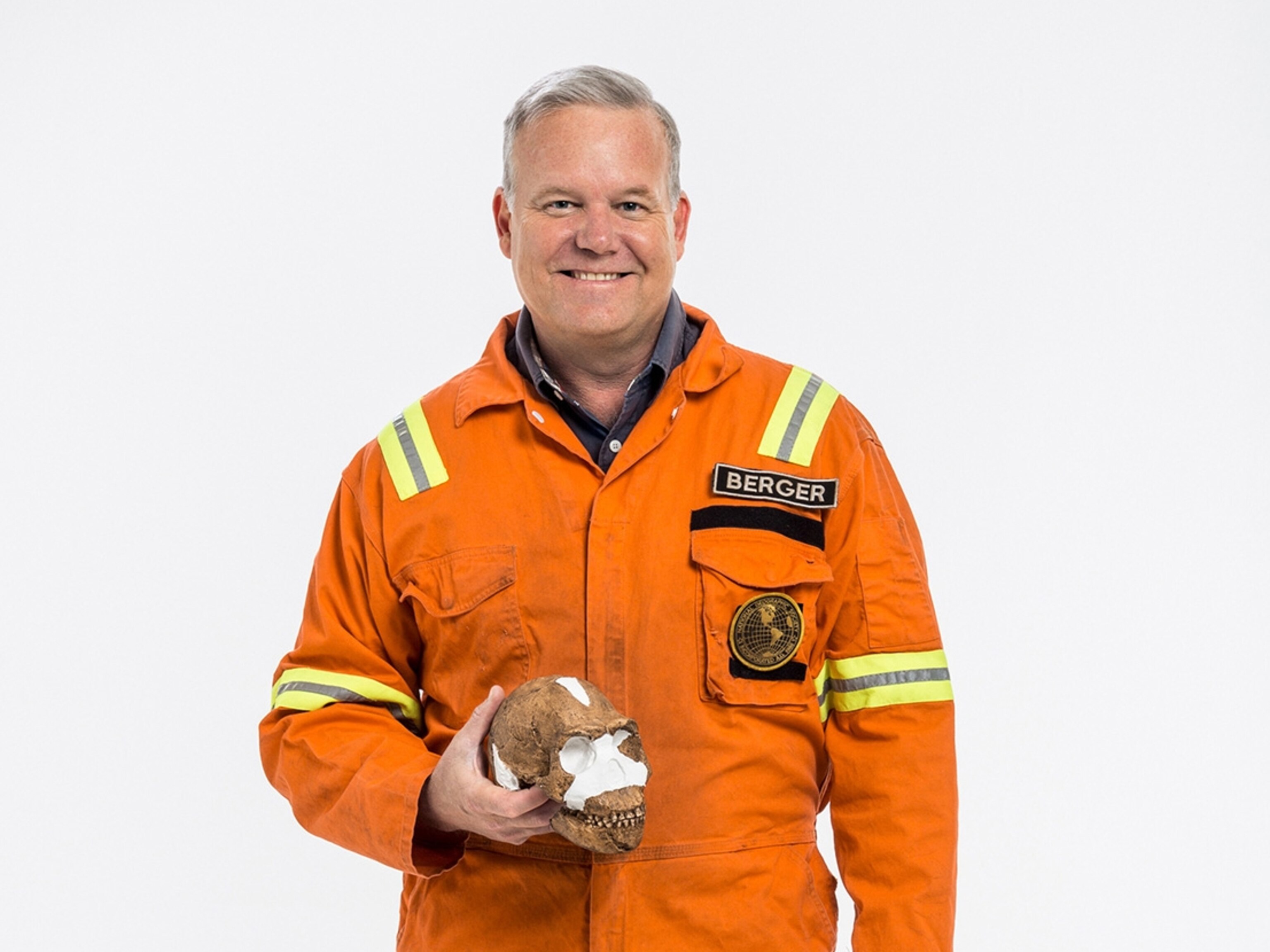
Fossil skulls rewrite the stories of two ancient human ancestors
Found in a hilltop cave, the oldest known Homo erectus and Paranthropus robustus fossils shed light on a critical period of hominin evolution.
In the winter of 2015, Jesse Martin and Angeline Leece were extracting what they thought were baboon remains from a piece of rock. The two students at La Trobe University in Australia were part of an expedition to collect and study fossils from the Drimolen quarry northwest of Johannesburg, South Africa. As they cleaned the skull fragments and pieced them back together, however, they realized the fossils did not come from a baboon, but instead comprised the braincase of a young Homo erectus, a species never before identified in South Africa.
“I don’t think our supervisors believed us until they came over to have a look,” Martin recalls.
The braincase was described in the journal Science today, together with the skullcap of another ancient hominin, Paranthropus robustus, found at the same site. A suite of different dating techniques all hinted that the two species’ braincases were more or less the same age—about two million years old. This would make them the earliest fossils ever found for their respective species, according to the new study coauthored by Martin and Leece.
“I think they have made a strong case for the oldest Homo erectus in Africa, and in fact, in the world,” Lee Berger, a paleoanthropologist at the University of Witwatersrand, says in an email. A National Geographic Society explorer-at-large, Berger was not involved in the new study.
The enigmatic origins of Homo erectus
The age of the fossils was particularly surprising for the Homo erectus skull. Most paleoanthropologists believe that this human ancestor arose in East Africa, where several younger Homo erectus fossils—as well as the likely remains of older Homo species—have been found. Some have even hypothesized that Homo erectus originated outside of Africa, because the oldest known fossils from the species—before this new find—were discovered at the site of Dmanisi in Georgia.
An Asian origin for H. erectus now seems exceedingly unlikely, Martin says. “The first problem for that idea is that the earliest evidence for Homo erectus is now from South Africa. But the bigger problem is that there is no candidate ancestor for Homo erectus in Asia. If you dig any deeper at sites where Homo erectus remains have been found, there are no hominins there.”
The discovery of the new braincase in South Africa, however, does not necessarily mean that Homo erectus originated there either. “Based on the current evidence, my guess is it emerged somewhere in Africa we haven’t looked yet,” Martin says.
Marcia Ponce de Léon, a paleoanthropologist at the University of Zürich in Switzerland who was not involved in the new study, agrees that “it is reasonable to call the new fossil Homo erectus.” A 2013 study by Ponce de Léon and colleagues described a 1.8-million-year-old hominin skull from Dmanisi, Georgia, identifying it as likely belonging to one of the earliest Homo erectus to leave Africa.
As the species migrated across continents, it continued to adapt to new environments. “Every population of every species continues to evolve wherever it goes,” Ponce de Léon says in an email. Tracing the spread and adaptation of Homo erectus halfway across the globe could help scientists learn more about the way our wandering ancestor survived in the different environments it encountered.
“This was really the first human experiment with globalization,” Martin says.
Three hominins in southern Africa
Two million years ago, Homo erectus wasn’t exactly abundant. “They appear to have been outnumbered 10 to 1 by Paranthropus robustus,” Leece says.
As its name indicates, Paranthropus robustus—one of the “robust australopithecines”—had a very stout skull, particularly large teeth, and an impressive crest on top of the braincase where its massive chewing muscles were attached. “The leading theory is that they were eating tough foods—not necessarily things that needed crunching, but foods that were fibrous and require a lot of chewing, like certain tubers or grasses,” Leece says.
The even older species Australopithecus sediba was also still roaming the region. The fossil record suggests this is about when Australopithecus started to be replaced by Paranthropus and Homo, a critical time in the evolution of our predecessor species.
For most of the year, Homo, Paranthropus, and Australopithecus species had plenty of available resources, and all three were likely eating more or less the same things. But winters can be harsh in this area, Martin says. “In the morning, it’s freezing, and according to estimates, it would’ve been even colder then. So this was quite a tough climate for a hominin.” Under those challenging circumstances, Paranthropus robustus’s powerful jaws and ability to eat tough, fibrous foods probably provided it with a significant advantage.
One theory holds that Australopithecus sediba may have been a direct ancestor to the genus Homo, including the species Homo erectus. The authors of the new study question this theory, however, as the newfound Homo erectus skull is older than Australopithecus sediba remains found at the nearby site of Malapa.
Berger, who was part of the team that found the Australopithecus sediba fossils at Malapa in 2010, believes that even though the Homo erectus skull is older, Australopithecus sediba still could have been an ancestor to the species. “Mother species can easily exist at the same time and place as their descendant species do,” he says.
Regardless of which of these species emerged first, one thing is clear: Over a million years later, only Homo erectus still walked the Earth.
Homo erectus conquers the world
While the hyperspecialized skull of Paranthropus robustus may have served it well in certain environments, the trait may have ultimately become its downfall, Leece says. When the environment changes, extreme adaptations can become a handicap.
Comparing the two newly analyzed braincases, it becomes clear that Homo erectus, while initially outcompeted by Paranthropus robustus, was working on a revolutionary adaptation of its own. H. erectus’s characteristic tear-shaped braincase suggests the early member of the Homo genus was expanding and reorganizing its brain.
The Homo erectus skull Martin and Leece wrested out of the rock did not belong to an adult. Judging by the extent to which the bones of the skull had already fused, the braincase came from a child between two and six years old. At this tender age, its brain would already have been larger than that of most Australopithecus and Paranthropus adults. And impressions on the fossils show that the child’s brain was still growing, pushing the skull bones outward. “We can even see blood vessels,” Martin says.
Whereas Paranthropus robustus evolved a kind of “portable grinding stone,” Homo erectus “adapted to be adaptable” and to solve all kinds of problems that it would have encountered along its journey from Africa to Asia and parts of southern Europe, Martin says. The species’ increasingly nimble brain allowed it to outsmart other animals by fashioning tools, collaborating with others, and perhaps even pondering the future.
Homo erectus survived for nearly two million years, making it the most successful species of Homo ever known, says Susan Antón, a paleoanthropologist at New York University who has studied Homo erectus remains from Africa and Asia. She writes in an email: “Homo sapiens may be more abundant right now than Homo erectus has ever been. But will we last for as long? Only time will tell.”
Related Topics
You May Also Like
Go Further
Animals
- He’s called ‘omacha,’ a dolphin that transforms into a man. Why?He’s called ‘omacha,’ a dolphin that transforms into a man. Why?
- Behind the scenes at America’s biggest birding festivalBehind the scenes at America’s biggest birding festival
- How scientists are piecing together a sperm whale ‘alphabet’How scientists are piecing together a sperm whale ‘alphabet’
- Orangutan seen using plants to heal wound for first timeOrangutan seen using plants to heal wound for first time
Environment
- He’s called ‘omacha,’ a dolphin that transforms into a man. Why?He’s called ‘omacha,’ a dolphin that transforms into a man. Why?
- The northernmost flower living at the top of the worldThe northernmost flower living at the top of the world
- This beautiful floating flower is wreaking havoc on NigeriaThis beautiful floating flower is wreaking havoc on Nigeria
- What the Aral Sea might teach us about life after disasterWhat the Aral Sea might teach us about life after disaster
- What La Palma's 'lava tubes' tell us about life on other planetsWhat La Palma's 'lava tubes' tell us about life on other planets
History & Culture
- This thriving society vanished into thin air. What happened?This thriving society vanished into thin air. What happened?
- These were the real rules of courtship in the ‘Bridgerton’ eraThese were the real rules of courtship in the ‘Bridgerton’ era
Science
- Is the 5-second rule true? Science finally has an answer.
- Science
- Gory Details
Is the 5-second rule true? Science finally has an answer. - E-bikes are good for the environment—but what about your health?E-bikes are good for the environment—but what about your health?
- Why trigger points cause so much pain—and how you can relieve itWhy trigger points cause so much pain—and how you can relieve it
Travel
- The story of this French village is set in stone — literallyThe story of this French village is set in stone — literally
- How to spend a long weekend in Zagreb, Croatia
- Paid Content
How to spend a long weekend in Zagreb, Croatia - The best LGBTQ-friendly destinations for every travelerThe best LGBTQ-friendly destinations for every traveler







